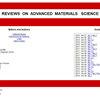在超高性能混凝土中将微型和纳米废玻璃与铸造废砂相结合,以提高材料性能和可持续性
IF 3.6
4区 材料科学
Q2 MATERIALS SCIENCE, MULTIDISCIPLINARY
引用次数: 0
摘要
在超高性能混凝土(UHPC)中使用含有微粒和纳米颗粒的废玻璃具有提高可持续性和材料性能的潜力,因此引起了人们的极大兴趣。本研究的重点是在废铸造砂中加入微废玻璃 (MG) 和纳米废玻璃的意义及其对 UHPC 性能的影响。当前工作的重点是抗压强度、抗拉强度、吸水率和微观结构。研究发现,MG 可提高抗压强度、降低抗拉强度、降低吸水率并使微观结构更加紧凑。结果表明,用 20% 的微玻璃替代水泥可达到最佳抗压强度,7 天时抗压强度提高了 11.6%,28 天时提高了 9.5%,56 天时提高了 10.18%。纳米废料玻璃由于其反应性增强和表面积增大,可加速硅酸钙水合物的形成并提高抗压强度。同时,纳米废料玻璃的有效利用提高了长期回弹性,在 1.5% 的替代率下,7 天、28 天和 56 天的最佳抗压强度分别为 17.5%、18.9% 和 16%。20% MG 和 1.5% 纳米废料玻璃的劈裂拉伸强度分别提高了 16% 和 21%。在含有铸造废砂的超高性能混凝土中使用 MG 和纳米废玻璃是提高材料性能和减少环境影响的有效方法。本文章由计算机程序翻译,如有差异,请以英文原文为准。
Integrating micro- and nanowaste glass with waste foundry sand in ultra-high-performance concrete to enhance material performance and sustainability
The utilization of waste glass with micro- and nanoparticles in ultra-high-performance concrete (UHPC) has garnered significant interest due to its potential to enhance sustainability and material performance. This study focuses on the implications of integrating microwaste glass (MG) and nanowaste glass in the presence of waste foundry sand and its impact on the properties of UHPC. The particular emphasis of the current work is on compressive strength, tensile strength, sorptivity, and microstructure. It is found that MG enhances compressive strength, decreased tensile strength, reduced sorptivity, and a more compact microstructure. The results indicate that replacing cement with 20% microglass achieves the optimal compressive strength by increasing up to 11.6% at 7 days, 9.5% at 28 days, and 10.18% at 56 days. Nanowaste glass, owing to its increased reactivity and larger surface area, accelerates calcium silicate hydrate formation and improves compressive strength. At the same time, the effective utilization of nanowaste glass improves long-term resilience with an optimum compressive strength at 1.5% replacement ratios of 17.5, 18.9, and 16% at 7, 28, and 56 days, respectively. Splitting tensile strength increased by 16% at 20% MG and 21% at 1.5% nanowaste glass, respectively. Utilizing MG and nanowaste glass in UHPC with waste foundry sand is a promising method for boosting material performance and minimizing environmental impact.
求助全文
通过发布文献求助,成功后即可免费获取论文全文。
去求助
来源期刊

Reviews on Advanced Materials Science
工程技术-材料科学:综合
CiteScore
5.10
自引率
11.10%
发文量
43
审稿时长
3.5 months
期刊介绍:
Reviews on Advanced Materials Science is a fully peer-reviewed, open access, electronic journal that publishes significant, original and relevant works in the area of theoretical and experimental studies of advanced materials. The journal provides the readers with free, instant, and permanent access to all content worldwide; and the authors with extensive promotion of published articles, long-time preservation, language-correction services, no space constraints and immediate publication.
Reviews on Advanced Materials Science is listed inter alia by Clarivate Analytics (formerly Thomson Reuters) - Current Contents/Physical, Chemical, and Earth Sciences (CC/PC&ES), JCR and SCIE. Our standard policy requires each paper to be reviewed by at least two Referees and the peer-review process is single-blind.
 求助内容:
求助内容: 应助结果提醒方式:
应助结果提醒方式:


